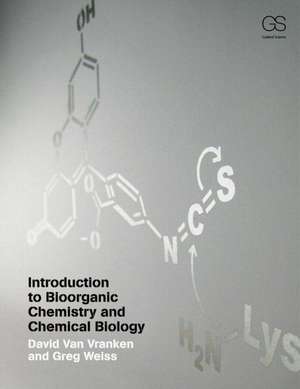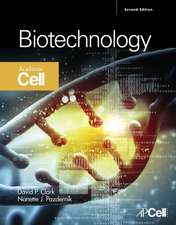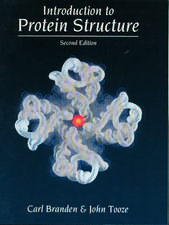Introduction to Bioorganic Chemistry and Chemical Biology
Autor David Van Vranken, Gregory A. Weissen Limba Engleză Paperback – 16 noi 2012
mechanistic arrow pushing, organic chemistry is used to illuminate the central dogma of molecular biology.
Introduction to Bioorganic Chemistry and Chemical Biology is appropriate for advanced undergraduate and graduate students in chemistry and molecular biology, as well as those going into medicine and pharmaceutical science.
Please note that Garland Science flashcards are no longer available for this text. However, the solutions can be obtained through our Support Material Hub link below, but should only be requested by instructors who have adopted the book on their course.
Preț: 550.68 lei
Preț vechi: 598.57 lei
-8% Nou
Puncte Express: 826
Preț estimativ în valută:
105.39€ • 109.62$ • 87.00£
105.39€ • 109.62$ • 87.00£
Carte disponibilă
Livrare economică 22 martie-05 aprilie
Livrare express 11-15 martie pentru 58.67 lei
Preluare comenzi: 021 569.72.76
Specificații
ISBN-13: 9780815342144
ISBN-10: 0815342144
Pagini: 504
Ilustrații: 547 colour illustrations
Dimensiuni: 210 x 280 x 18 mm
Greutate: 1.24 kg
Ediția:New.
Editura: CRC Press
Colecția Garland Science
ISBN-10: 0815342144
Pagini: 504
Ilustrații: 547 colour illustrations
Dimensiuni: 210 x 280 x 18 mm
Greutate: 1.24 kg
Ediția:New.
Editura: CRC Press
Colecția Garland Science
Cuprins
1. Fundamentals of Chemical Biology
2. The Chemical Origins of Biology
3. DNA
4. RNA
5. Peptide and Protein Structure
6. Protein Function
7. Glycobiology
8. Polyketides & Terpenes
9. Chemical Control of Signal Transduction
A sample chapter and detailed table of contents are available at www.garlandscience.com/bioorganic-chembio.
2. The Chemical Origins of Biology
3. DNA
4. RNA
5. Peptide and Protein Structure
6. Protein Function
7. Glycobiology
8. Polyketides & Terpenes
9. Chemical Control of Signal Transduction
A sample chapter and detailed table of contents are available at www.garlandscience.com/bioorganic-chembio.
Recenzii
“Introduction to Bioorganic Chemistry and Chemical Biology fills a gap in the available literature by presenting the necessary basics of biochemistry from the viewpoint of organic chemistry, as well as explaining how to use the principles described in the book for the design and application of molecular tools…[It] is a didactically excellent textbook for readers who already have experience in chemistry, and provides an appealing and comprehensible introduction to this multifaceted field of research between chemistry and biology.”
- Angewandte Chemie
“This book provides important information on the organic chemistry of biooligomers and their interactions in the functioning of cells. Advanced undergraduate students, graduate students in chemistry and molecular biology, as well as medical students will find this book of value.”
- Doody Reviews
“It is often said that juxtaposing two separate fields can generate new ideas and ways of thinking. This is the approach that the authors have taken here by aiming, according to the blurb on the back of the book, to ‘blend modern tools of organic chemistry with concepts of biology, physiology, and medicine’. They have succeeded….The text is clearly set out and there is good coverage of all aspects of the subject area ranging from the structure of DNA to gene chip technology….I am sure that both organic chemists and biologists will gain from the novel approach to teaching the subject matter.”
- The Biologist
“I would wholeheartedly support this approach to the teaching of biological chemistry. Many of the traditional textbooks present biochemical pathways in a way that encourages rote learning without developing any understanding of the reactions in terms of atoms, bonds and mechanistic organic chemistry. This book appears to be different, and it is refreshing to see many chemical structures and curly arrow pushing mechanisms.”
- James Redman, Cardiff University, UK
“From this preview, this is an excellent book. Contents are up to date and the presentation is fluid, evenly paced, and supported with interesting features (boxes, extra figures, interesting stories along the way). Being a chemist myself, I find this book very appealing and will consider it for an advanced undergraduate course that focuses on chemical applications in biology.”
- Gerwald Jogl, Brown University, USA
“The [end-of-chapter] problems are very useful, as it is hard to generate suitable problems de novo each time one teaches a bioorganic course. Undergraduate students could use this in multiple courses (bioorganic chemistry, natural products, etc). I suspect that this will evolve into a highly useful resource book and textbook for students.…Overall, the book is excellent.”
- Paul Harrison, McMaster University, Canada
"[Introduction to Bioorganic Chemistry and Chemical Biology's] clarity and engaging style would make it an excellent resource in a chemical biology course geared toward undergraduates who have completed two semesters of organic chemistry or first-year graduate students with a firm understanding of organic chemistry but limited exposure to biology and biochemistry." - The Quarterly Review of Biology
- Angewandte Chemie
“This book provides important information on the organic chemistry of biooligomers and their interactions in the functioning of cells. Advanced undergraduate students, graduate students in chemistry and molecular biology, as well as medical students will find this book of value.”
- Doody Reviews
“It is often said that juxtaposing two separate fields can generate new ideas and ways of thinking. This is the approach that the authors have taken here by aiming, according to the blurb on the back of the book, to ‘blend modern tools of organic chemistry with concepts of biology, physiology, and medicine’. They have succeeded….The text is clearly set out and there is good coverage of all aspects of the subject area ranging from the structure of DNA to gene chip technology….I am sure that both organic chemists and biologists will gain from the novel approach to teaching the subject matter.”
- The Biologist
“I would wholeheartedly support this approach to the teaching of biological chemistry. Many of the traditional textbooks present biochemical pathways in a way that encourages rote learning without developing any understanding of the reactions in terms of atoms, bonds and mechanistic organic chemistry. This book appears to be different, and it is refreshing to see many chemical structures and curly arrow pushing mechanisms.”
- James Redman, Cardiff University, UK
“From this preview, this is an excellent book. Contents are up to date and the presentation is fluid, evenly paced, and supported with interesting features (boxes, extra figures, interesting stories along the way). Being a chemist myself, I find this book very appealing and will consider it for an advanced undergraduate course that focuses on chemical applications in biology.”
- Gerwald Jogl, Brown University, USA
“The [end-of-chapter] problems are very useful, as it is hard to generate suitable problems de novo each time one teaches a bioorganic course. Undergraduate students could use this in multiple courses (bioorganic chemistry, natural products, etc). I suspect that this will evolve into a highly useful resource book and textbook for students.…Overall, the book is excellent.”
- Paul Harrison, McMaster University, Canada
"[Introduction to Bioorganic Chemistry and Chemical Biology's] clarity and engaging style would make it an excellent resource in a chemical biology course geared toward undergraduates who have completed two semesters of organic chemistry or first-year graduate students with a firm understanding of organic chemistry but limited exposure to biology and biochemistry." - The Quarterly Review of Biology
Notă biografică
David Van Vranken, Gregory A. Weiss
Descriere
This textbook uniquely blends the modern tools of organic chemistry with concepts of biology, physiology, and medicine. With a focus on human cell biology and using a problems-driven approach, the text explains the combinatorial architecture of biooligomers (genes, DNA, RNA, proteins, glycans, lipids, and terpenes) as the molecular engine for life. Accentuated by descriptions of mechanistic arrow pushing and rich illustrations, organic chemistry is used to illuminate the central dogma of molecular biology. The text contains more than 300 problems to test assimilation or the material.












